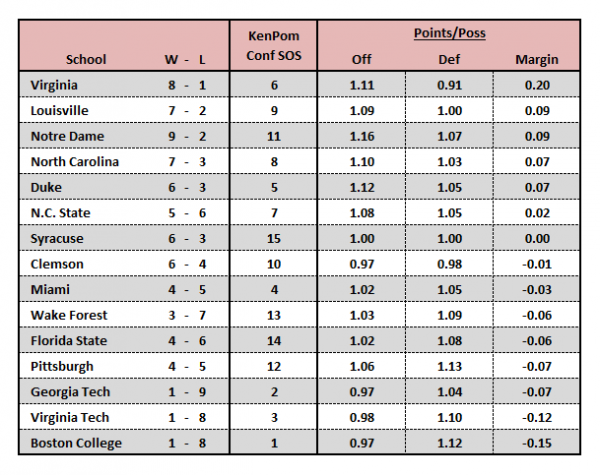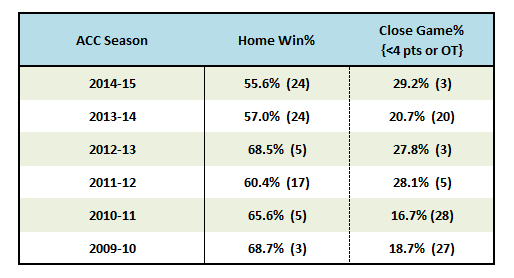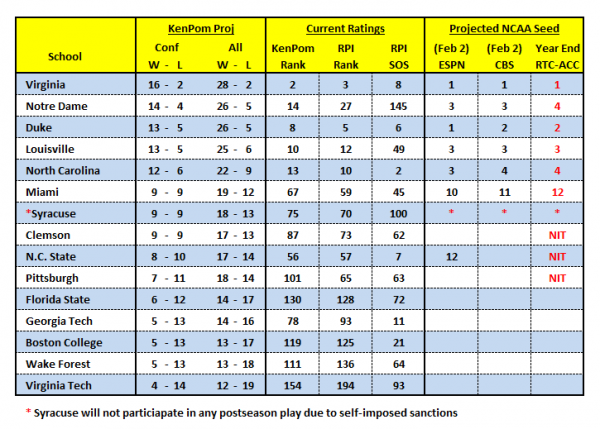Inside the ACC Numbers: Volume III
Posted by Brad Jenkins (@bradjenk) on February 6th, 2015This is the latest edition of a weekly look at the current ACC standings and corresponding team performances, focusing on the teams that are playing better or worse than their records might indicate. We will also delve into some advanced metrics to find a few interesting team or player stats and trends. Finally, we will forecast how the final standings may look, and what that means for ACC schools’ postseason aspirations.
Note: All numbers are current for games played through Wednesday, February 4.
Current Standings
With the conference season now just past the halfway point, some distinct tiers are forming with respect to points per possession margin (PPM). Virginia is clearly in a class by itself even though the Cavaliers hold a very slim one-game lead in the standings. Behind Virginia is a four-team group that’s looks very similar in both the standings and in PPM. Every weekend features a couple of great match-ups between the ACC heavyweights and this Saturday is no exception. Louisville travels to Charlottesville (7:00 PM ET – ESPN) for the first of two meetings with the Cavaliers, and Duke gets a chance for revenge when it hosts Notre Dame (1:00 PM ET – CBS). If both home clubs prevail, Virginia will have a two-game lead in the loss column over the other four legitimate contenders – assuming that North Carolina also wins Saturday afternoon at Boston College.
The ACC’s middle tier has a new member this week, as Clemson has quietly risen in both the standings and PPM by winning four straight games. Unsurprisingly, the Tigers’ defense has been the driving force behind the streak, as Clemson has held all four opponents under 0.90 points per possession. Also since last week’s review, Georgia Tech dropped two more close games and holds the unofficial title of the ACC’s least fortunate team. Not only have the Yellow Jackets performed basically the same as Pittsburgh, they have also played a far tougher conference slate than the Panthers. Brian Gregory’s reward: Georgia Tech has three fewer conference wins than Pitt and Gregory’s position on the coaching hot seat is burning.
Advanced Stat of the Week: The ACC’s Disappearing Home Court Advantage
Ken Pomeroy has an interesting little section on the conference page section of his website where he lists each league’s percentage of home court wins and its ranking among the 32 Division I conferences. Data for percentage of close games and blowout wins is also available. In the below table we show how KenPom’s top six rated leagues compare in those three statistics.
What happened to all those reputedly tough home venues in the ACC? An ACC road team is just about as likely to win away from home as not this season — as a comparison, it appears that the rowdy home crowds in the Big Ten and Big 12 are doing their jobs. On the other hand, if it’s close and exciting games you like, the ACC and the Big East are where you want to be this year. Stay away from the Pac-12 — with roughly a fourth of its conference games resulting in blowouts, maybe Bill Walton in the analyst’s chair is the only compelling reason to watch that league’s action. Getting back to the topic of home court edge, let’s look at the ACC’s last six years to see if this season represents a fluke or a trend.
Although the sample size is small, we may be looking at a trend that is traceable to the first year of the last expansion when the addition of three former Big East schools (Syracuse, Pittsburgh, Notre Dame) pushed the ACC’s roster of schools to 15 (with Louisville replacing Maryland this year). After a home court winning edge of roughly 65 percent from 2009-13, visiting teams suddenly started to have a better time of it over the last two years. This could be a statistical anomaly, but it could also represent a new reality and an unintended consequence of football-driven expansion. ACC schedules are all over the map, and with schools not visiting each other as often, excitement and familiarity among fans has waned. There are few things worse for fans than to have their team lose an early road conference game and not get the opportunity for revenge later that year. Alarmingly low attendance figures at schools like Florida State, Miami, and Clemson could indicate growing fan apathy. Fortunately, though, after a one-year scarcity of close games, the ACC has reverted back to a level of competitiveness at a rate comparable to its last two seasons as a 12-team league.
Future Forecast
The above table shows a predicted order of finish with final regular season records based on Ken Pomeroy’s current win probabilities. The big news here is with Syracuse announcing that it will not participate in postseason play this year, which may not have mattered much as we expected the Orange to tumble anyway. We have also included a few comparative rankings that are mentioned frequently when evaluating NCAA Tournament potential as well as projections from two bracketology experts, ESPN‘s Joe Lunardi and CBS Sports‘ Jerry Palm. Note that while their projections are made as if the field was named tomorrow, we make ours based on final projected records. Pittsburgh’s recent win over Notre Dame pushed the Panthers closer to the NCAA bubble but they still have a lot of work to do to become a serious contender. Miami’s recent slump has the Hurricanes teetering on the edge of the projected field, and we are probably being overly generous by including them at all right now. But we have faith that Jim Larranaga will right the ship and get the Hurricanes back on track sooner than later.














































